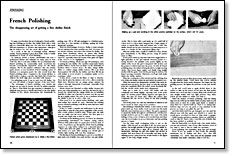
Synopsis: Anthony Arlotta, a professional finisher and refinisher and former cabinetmaker, is an ardent supporter of French polishing and shows here how to achieve the smooth, thin finish full of luster. The article details the disadvantages of using this finish but shows how to achieve it on fine furniture that is properly cared for. Here, you can follow the steps Arlotta takes, from dissolving shellac chips or buttons in alcohol, choosing a stain, washing the piece with the shellac, and sanding. Arlotta uses 4F pumice stone as filler, lemon oil as lubricant, and cotton or wool pads for rubbing.
To many woodworkers the art of satin-gloss French polishing—the building up of a thin, fine shellac finish with a cloth pad—is a deservedly dying one. Not only docs it take much skill and experience to produce that transparent, satin-gloss that it’s famous for, but also much elbow grease.
As a result, in this day of seemingly instant, effortless activity, French polishing is given short shrift, rarely or briefly mentioned in books on wood finishing.
To Anthony Arlotta, a former cabinetmaker and now a professional finisher and refinisher for many years in New York City, this is a sad state of affairs. He can understand why French polishing for commercially made woodwork has become economically impractical except for the finest antiques. But for the amateur craftsman, who has already spent dozens or even hundreds of hours making a piece of furniture or a marquetry panel, the extra several hours that French polishing takes, compared to the instant finishes, is well worth it. It gives a smooth, thin finish full of luster but without the thick high gloss associated with lacquer.
For refinishing work, it can be used over old shellac, but not over old varnish or lacquer because of the poor bond.
The advantages of French polishing over varnish ana lacquer are not only its beauty, but also its relative practicality. That is, if the finish does get scratched or damaged, it’s a relatively easy process to rebuild and blend in the new shellac buildup. In fact, Arlotta demonstrates this dramatically by putting some 150 or 180 grit sandpaper to a finished piece, and then, in a few minutes of rubbing, getting rid of the intentional scratches.
There are disadvantages, however. Shellac is water resistant but not waterproof as some varnishes are. And, of course, it is not alcohol resistant, since that is the solvent for shellac. But given these drawbacks, there’s no reason why French polishing can’t be used for any fine furniture that is properly cared for, especially where the beauty of the grain and figure of the wood is to be highlighted.
For French polishing, Arlotta uses age old techniques, such as mixing his own shellac. (He considers ready-made French polishes inferior, but he does use them—on the undersides of furniture where it doesn’t show.) He takes orange shellac flakes or crushed orange shellac buttons, fills a jar about three-quarters full with the dry shellac, and then fills the jar with methyl or wood alcohol, or columbine spirits, as it is sometimes called.
It takes about a week for the flakes or chips to dissolve. Every day he gives the mixture a stir or two; after a week the flakes have dissolved into an orange syrupy mixture. He strains it through cheesecloth if necessary, especially if the buttons were used.
From Fine Woodworking #1
For the full article, download the PDF below:
Fine Woodworking Recommended Products

Veritas Wheel Marking Gauge

Stanley Powerlock 16-ft. tape measure

Diablo ‘SandNet’ Sanding Discs






















Log in or create an account to post a comment.
Sign up Log in